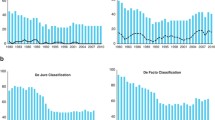Abstract
This paper assumes that the major industrial countries (and probably most other major countries) will continue to employ inflation targeting and allow their exchange rates to float, in the sense of accepting no obligation to hold the rate at any particular level. However, it points out that floating may be interpreted in three different ways: as free floating, as permitting ad hoc intervention (with no rules, except possibly that there should be no “manipulation” of the exchange rate), and as managed floating, with the rules and parameters publicly announced. The latter can in turn be accomplished either by prescribing rules relating to changes or levels in the exchange rate. The paper argues in favor of a system of managed floating in which the rules prohibit intervention that would push the exchange rate away from an internationally agreed reference rate. It discusses the problems that would arise in calculating and agreeing a set of reference rates. While these would undoubtedly be serious, the prize is a system that would allow—but not compel—countries to attempt to limit the misalignments of their currency, and that would give the IMF a basis for effective surveillance.
Similar content being viewed by others
Notes
I define non-substantive intervention as encompassing reserve changes as a result of the government’s own transactions and smoothing intervention.
The best attempt to give this concept some meaning has been made by my colleague Morris Goldstein in Truman (2006), but his proposed answer does not seem to have resonated in official circles.
See, for example, Cline (2005).
It follows that tests of the effectiveness of intervention that treat all interventions as equal, irrespective of whether the central bank is trying to reduce a misalignment or defy the market, are worthless.
Examples of legitimate controls would be controls on the import of firearms or drugs.
There is an obvious problem with this criterion: A country with an exchange rate that is undervalued by the market might be subjected to inflation if the country bowed to IMF advice and expanded demand. (Similarly, a country whose exchange rate is overvalued by the market, as judged by the reference rate calculations endorsed by the IMF, could be pushed into deflating demand and causing recession.) The IMF would need to be aware of this potential difficulty and request only modest policy adjustments, but one can hold the view that it is desirable to create ex ante demand conditions that will support adjustment if and when the market recognizes reality and brings the exchange rate to the vicinity of the reference rate.
Krugman (1991) termed this “the Mass. Avenue model”, since it is the theory embraced both in Mass Ave, Cambridge Mass and Mass Ave, Washington D.C.
Or average income over the cycle; the two will be equivalent unless some areas systematically operate at a lower pressure of demand.
References
Cline WR (2005) The case for a new plaza agreement. Policy Brief no. 05-4. Institute for International Economics, Washington
Cooper RN (1994) Comment on Chapter 2. In: Kenen PB (ed) Managing the world economy: fifty years after Bretton Woods. Institute for International Economics, Washington
Dominguez KM, Frankel JA (1993) Does foreign exchange market intervention work? Institute for International Economics, Washington, DC
Ethier W, Bloomfield AI (1975) Managing the managed float. Princeton Essays in International Finance no. 112. International Finance Section, Princeton
Fratzscher M (2004) Exchange rate policy strategies and foreign exchange interventions in the group of three economies. In: Bergsten CF, Williamson J (eds) Dollar adjustment: how far? Against what? Institute for International Economics, Washington
Jurgensen P (1983) Report of the working group on exchange market intervention. Washington, DC: U.S. Department of the Treasury (March), processed
Krugman P (1991) Has the adjustment process worked? In: Bergsten CF (ed) International adjustment and financing: the lessons of 1985-91. Institute for International Economics, Washington
Kubelec C (2004) Intervention when exchange rate misalignments are large. In: Bergsten CF, Williamson J (eds) Dollar adjustment: how far? Against what? Institute for International Economics, Washington
Meese R, Rogoff K (1983) Empirical exchange rate models of the 1970s: do they fit out of sample? J Int Econ 14:1–2, February
Obstfeld M, Rogoff K (1995) The intertemporal approach to the current account. In: Grossman GM, Rogoff K (eds) Handbook of international economics Vol. III. Elsevier, Amsterdam
O’Neill J, Ades A, Choksy H, Nordvig J, Stolper T (2005) Merging GSDEER and GSDEEMER: a global approach to equilibrium exchange rate modelling. Goldman Sachs Global Economics Paper no. 124. Available at https://portal.gs.com
Sarno L, Taylor MP (2001) Official intervention in the foreign exchange market: is it effective and, if so, how does it work? J Econ Lit 39(September):839–868
Schwartz AJ (2000) The rise and fall of foreign exchange market intervention. NBER Working Paper No. W7751
Truman EM (2003) The limits of exchange market intervention. In: Bergsten CF, Williamson J (eds) Dollar overvaluation and the world economy. Institute for International Economics, Washington
Truman EM (2006) Reforming the IMF for the 21st Century. Institute for International Economics
Williamson J (1994) Estimating equilibrium exchange rates. Institute for International Economics, Washington
Williamson J (2003) Exchange rate policy and development. Presented at a conference of the Initiative for Policy Dialogue in Barcelona
Wonacott P (1958) Exchange stabilization in Canada, 1950-54: A Comment. Canadian Journal of Economics and Political Science. May
Author information
Authors and Affiliations
Corresponding author
Additional information
A paper presented at a workshop organized by the Bank of Greece and the Oesterreichische Nationalbank on 24-25 February 2006 in Vienna and to be published in International Economics and Economic Policy. The author is indebted to Edwin Truman, Richard Cooper, Randy Henning, workshop participants, and those at a seminar at the University of Warwick for comments on previous drafts.
Rights and permissions
About this article
Cite this article
Williamson, J. A worldwide system of reference rates. IEEP 3, 341–352 (2006). https://doi.org/10.1007/s10368-006-0069-x
Published:
Issue Date:
DOI: https://doi.org/10.1007/s10368-006-0069-x




